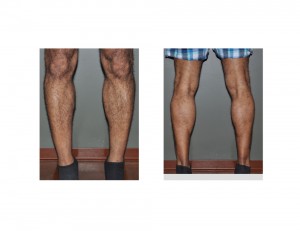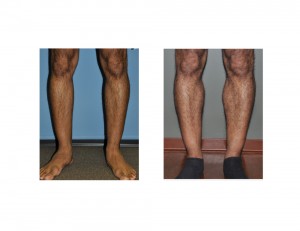Background: One of the majn features of the lower leg is that of the calfs. The size of the calfs is due to its muscles which contribute to the shape of the leg below the knee. If they are well developed, the leg is seen as very muscular and athletic. If they are underdeveloped and very thin one can be perceived as having skinny or ‘chicken’ legs.
The calf region is composed of the gastrocnemius muscles. It gets its name from being called the ‘stomach of the leg’ as it causes a bulge in the back part of the lower leg. It has two separate muscle bellies being a bipennate muscle known as the inner and outer heads of the gastrocnemius muscle. If one includes the deeper soleus muscle, they are a large combined superficial muscle that runs down from the knee and attaches to the heel bone through the achilles tendon.
While calf muscles can be developed through exercise alone, it can be difficult due to the tight and small muscle fibers which comprise it. Even if one can develop significant gastrocnemius muscle enlargement by fiber hypertrophy, it is not sustainable without continued weight training. In addition, some people with little calf muscle mass do not want to undergo an exercise program to try and enlarge them.
Case Study: This 40 year-old male wanted to improve the shape of his skinny lower legs. He felt he had ‘chicken legs’ and stated he was often referred to as such. He was not an exercise enthusiast and wanted calf implants. The question was whether to augment both heads of the calf muscles or just the inner head. He elected to have a single implant per leg to improve the inner leg bulge.



Case Highlights:
1) Soft silicone elastomer calf implants can create a permanent cosmetic enhancement of the gactrocnemius muscle.
2) The proper placement for a calf implant is under the fascia but on top of the muscle.
3) When placed bilaterally over the medial heads of the gastrocnemius muscles, a more shapely inner lower leg shape is obtained.
Dr. Barry Eppley
Indianapolis, Indiana



